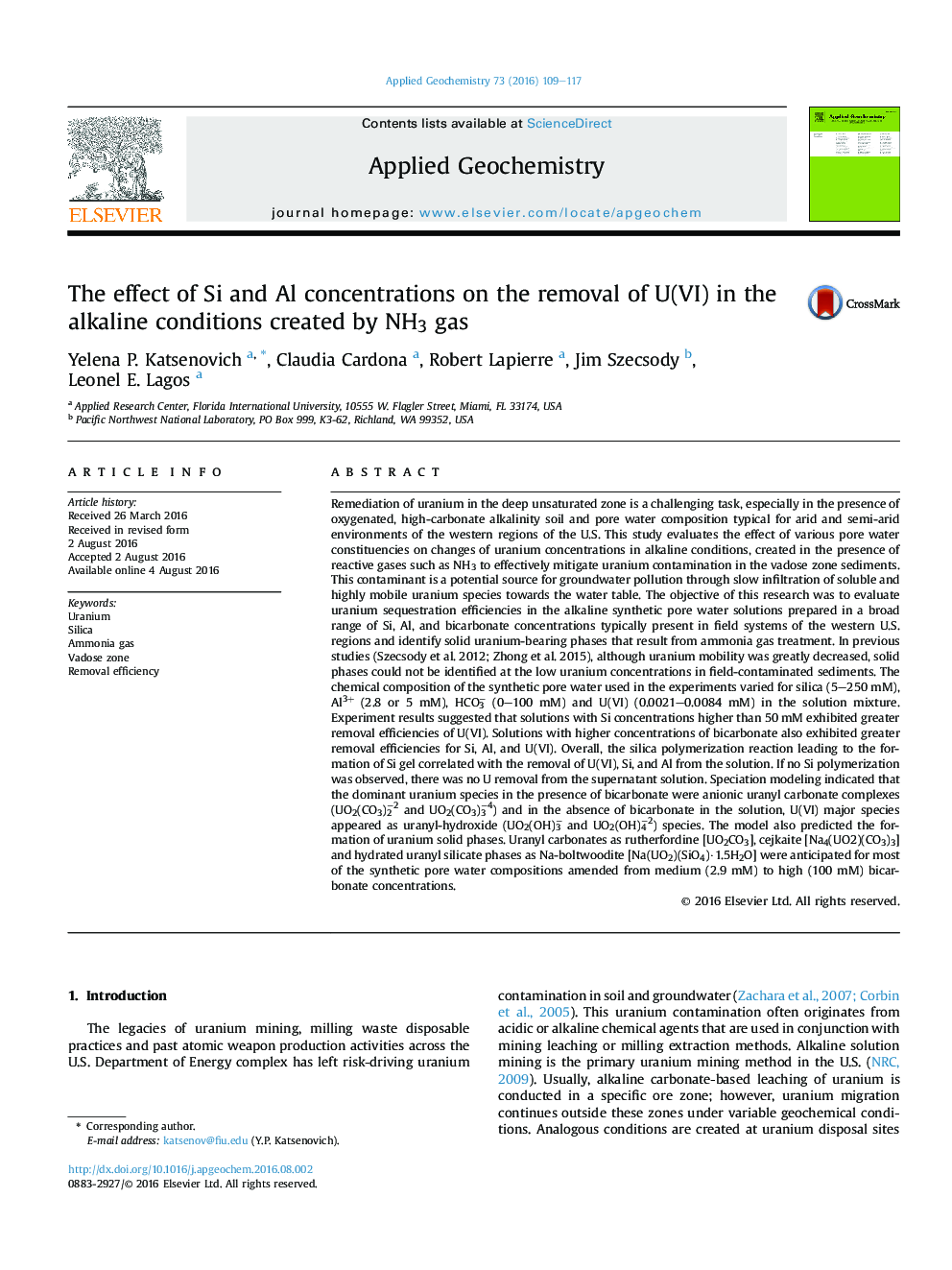| کد مقاله | کد نشریه | سال انتشار | مقاله انگلیسی | نسخه تمام متن |
|---|---|---|---|---|
| 4435542 | 1620218 | 2016 | 9 صفحه PDF | دانلود رایگان |

• The removal efficiency of uranium was not significantly affected by the different U(VI) concentrations tested.
• The solutions with higher concentrations of Si, Al and bicarbonate tended to have greater removal efficiencies of U(VI).
• The formation of amorphous Si always correlated with the removal of U(VI), Si, and Al from the solution.
• If no Si polymerization was observed, there was no U removal from the supernatant solution.
• Na-boltwoodite and uranyl carbonate solid phases were predicted as predominant in the presence of bicarbonate.
Remediation of uranium in the deep unsaturated zone is a challenging task, especially in the presence of oxygenated, high-carbonate alkalinity soil and pore water composition typical for arid and semi-arid environments of the western regions of the U.S. This study evaluates the effect of various pore water constituencies on changes of uranium concentrations in alkaline conditions, created in the presence of reactive gases such as NH3 to effectively mitigate uranium contamination in the vadose zone sediments. This contaminant is a potential source for groundwater pollution through slow infiltration of soluble and highly mobile uranium species towards the water table. The objective of this research was to evaluate uranium sequestration efficiencies in the alkaline synthetic pore water solutions prepared in a broad range of Si, Al, and bicarbonate concentrations typically present in field systems of the western U.S. regions and identify solid uranium-bearing phases that result from ammonia gas treatment. In previous studies (Szecsody et al. 2012; Zhong et al. 2015), although uranium mobility was greatly decreased, solid phases could not be identified at the low uranium concentrations in field-contaminated sediments. The chemical composition of the synthetic pore water used in the experiments varied for silica (5–250 mM), Al3+ (2.8 or 5 mM), HCO3− (0–100 mM) and U(VI) (0.0021–0.0084 mM) in the solution mixture. Experiment results suggested that solutions with Si concentrations higher than 50 mM exhibited greater removal efficiencies of U(VI). Solutions with higher concentrations of bicarbonate also exhibited greater removal efficiencies for Si, Al, and U(VI). Overall, the silica polymerization reaction leading to the formation of Si gel correlated with the removal of U(VI), Si, and Al from the solution. If no Si polymerization was observed, there was no U removal from the supernatant solution. Speciation modeling indicated that the dominant uranium species in the presence of bicarbonate were anionic uranyl carbonate complexes (UO2(CO3)2−2 and UO2(CO3)3−4) and in the absence of bicarbonate in the solution, U(VI) major species appeared as uranyl-hydroxide (UO2(OH)3− and UO2(OH)4−2) species. The model also predicted the formation of uranium solid phases. Uranyl carbonates as rutherfordine [UO2CO3], cejkaite [Na4(UO2)(CO3)3] and hydrated uranyl silicate phases as Na-boltwoodite [Na(UO2)(SiO4)·1.5H2O] were anticipated for most of the synthetic pore water compositions amended from medium (2.9 mM) to high (100 mM) bicarbonate concentrations.
Journal: Applied Geochemistry - Volume 73, October 2016, Pages 109–117